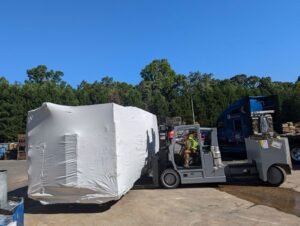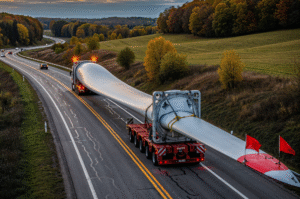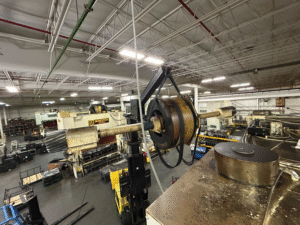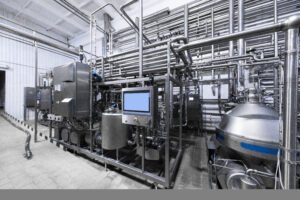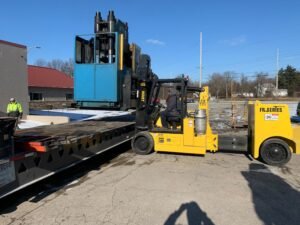In the competitive world of food manufacturing, efficiency, hygiene, safety, and durability are not just operational priorities—they are fundamental requirements. Behind the scenes of every productive food processing plant is a vast network of carefully engineered systems, structures, and machinery. At the heart of this infrastructure lies industrial fabrication—a critical component that shapes the functionality and success of modern food production facilities.
From stainless steel conveyors and custom tanks to structural platforms and hygienic enclosures, industrial fabrication encompasses the design, manufacturing, and installation of customized components tailored to the specific needs of the food processing industry. This article explores the significance, process, and benefits of industrial fabrication for food processing plants, along with the industry’s strict compliance demands, evolving technologies, and the importance of selecting the right fabrication partner.
The Importance of Fabrication in Food Processing
Food processing plants operate under tight regulations. Every piece of equipment and every square foot of facility space must adhere to standards designed to protect public health and streamline production. Industrial fabrication plays an indispensable role in enabling plants to meet these standards by providing:
-
Custom Solutions: Every food processing plant has a unique layout, product line, and processing workflow. Fabrication allows for customization that mass-produced equipment simply cannot offer.
-
Sanitation Assurance: Food contact surfaces, storage vessels, and processing tools must be designed with cleanability in mind. Proper fabrication reduces the risk of microbial contamination.
-
Structural Integrity: Many food operations involve extreme temperatures, high-pressure cleaning, and heavy loads. Fabricated components must withstand these stresses over time.
-
Operational Efficiency: Properly fabricated systems improve workflow, minimize bottlenecks, and support continuous production lines.
Fabrication ensures that systems align with production goals while remaining compliant with sanitation and safety requirements—both of which are critical in food handling environments.
Materials Used in Food Industry Fabrication
When it comes to fabrication for food processing, not all materials are created equal. Selection depends on application, environmental conditions, and regulatory requirements. Some of the most commonly used materials include:
1. Stainless Steel
The gold standard in food-grade fabrication, stainless steel—particularly grades like 304 and 316—is known for its corrosion resistance, non-reactivity, and ease of sanitation. Stainless steel is used in fabricating:
-
Conveyors
-
Storage tanks
-
Process piping
-
Washdown enclosures
-
Equipment frames
316 stainless steel, with added molybdenum, offers superior resistance to chlorides and is often used in marine and dairy applications.
2. Food-Grade Plastics
High-density polyethylene (HDPE), polypropylene (PP), and UHMW (ultra-high-molecular-weight polyethylene) are common in cutting surfaces, guide rails, and non-load bearing applications due to their lightweight properties and resistance to bacterial absorption.
3. Aluminum
Though less frequently used in direct-contact areas, aluminum serves as a structural material where weight reduction is needed. It’s important to anodize aluminum to improve its resistance to corrosion in moist environments.
Proper material selection is a collaborative process between engineers, food safety officers, and fabrication specialists to ensure long-term performance and compliance.
Fabrication Processes for Food Processing Plants
The fabrication of components and infrastructure for food processing involves several steps, often taking raw material through cutting, forming, welding, assembly, and finishing. Some of the key fabrication processes include:
Cutting and Shaping
Using tools such as CNC laser cutters, plasma cutters, and waterjet machines, raw sheet metal is precisely cut to meet exact specifications. Precision is crucial to ensure clean edges and minimize microcrevices that could harbor bacteria.
Forming and Bending
Press brakes and rollers bend metal into desired shapes. Whether it’s forming a chute, a tank shell, or a machine guard, these operations must be carefully controlled to avoid warping and maintain structural integrity.
Welding and Assembly
Welding is a cornerstone of food-grade fabrication. TIG (tungsten inert gas) welding is most commonly used for stainless steel applications because of its clean, strong, and smooth finish. Continuous, polished welds reduce microbial harborage points and support CIP (Clean-In-Place) processes.
Surface Finishing
Surfaces are polished or electropolished to enhance cleanability. A smooth, mirror-like finish on food-contact areas ensures easy sanitation and minimizes biofilm development. Surface roughness (Ra) is a key measure here, with <0.8 µm Ra considered sanitary grade.
Installation
Once fabricated, systems are installed in alignment with the plant’s production flow. This includes aligning conveyors, anchoring tanks, ensuring level platforms, and integrating piping with process equipment.
Key Applications of Industrial Fabrication in Food Plants
Fabrication isn’t limited to building standalone equipment. It spans a broad spectrum of applications in food processing environments:
1. Conveyor Systems
Custom conveyors are fabricated to move products efficiently between processes—sorting, weighing, cooking, cooling, or packaging. Belts, frames, and support structures are tailored for easy cleaning and accessibility.
2. Storage Tanks and Mixing Vessels
Fabricated tanks are designed to withstand temperature changes and agitation. Whether storing dairy, oils, sauces, or dry goods, vessels are constructed to meet strict hygiene standards and pressure requirements.
3. Platforms and Catwalks
Access structures are fabricated for operator safety and ergonomic workflow. Non-slip treads, handrails, and easy-to-clean finishes are essential features for safe use in wet or greasy environments.
4. Process Piping
Food-grade piping must accommodate product flow without contamination. Sanitary welds, proper slope for drainage, and CIP systems are integral to fabricated piping assemblies.
5. Machine Enclosures and Guards
Protective enclosures are designed to safeguard workers while maintaining food hygiene. Transparent panels, stainless housings, and quick-release access doors are often fabricated as part of equipment safety upgrades.
Compliance and Regulatory Considerations
Fabrication for food processing is governed by a host of regulations designed to protect public health. Fabricators must be well-versed in these requirements to produce compliant and audit-ready systems.
FDA and USDA Guidelines
These regulatory bodies provide directives on the materials, finishes, and design standards used in food equipment. Fabricated components must be non-toxic, non-absorbent, and easily cleanable.
3-A Sanitary Standards
Common in dairy and beverage industries, 3-A standards specify criteria for the hygienic design and fabrication of equipment. These include sanitary welds, drainability, and clean-in-place compatibility.
HACCP Integration
Fabricated systems should support a facility’s Hazard Analysis and Critical Control Points (HACCP) plan. Equipment should be designed to prevent contamination and allow for thorough inspection and cleaning.
OSHA Compliance
Platforms, staircases, and safety guards must comply with Occupational Safety and Health Administration (OSHA) standards to protect workers operating in potentially hazardous environments.
The Role of Engineering in Fabrication
Industrial fabrication is not merely a manual trade—it is deeply rooted in engineering principles. Structural engineers, mechanical designers, and sanitary engineers all play a part in ensuring fabricated systems meet load requirements, environmental demands, and regulatory obligations.
Custom Design
Fabrication shops often begin with 3D modeling using CAD (Computer-Aided Design) software. This allows the team to simulate how the equipment will function within the plant layout and to identify any potential conflicts or inefficiencies.
Load Calculations
Platforms, tanks, and supporting structures are designed to hold specific weights safely. Engineers calculate static and dynamic loads, vibration tolerances, and impact resistance.
Thermal and Flow Modeling
When dealing with heated tanks or pressurized pipes, thermal expansion and fluid dynamics must be considered. Fabricators work with engineers to ensure that systems are safe, effective, and energy efficient.
Modern Innovations in Food Industry Fabrication
Fabrication is evolving rapidly, with new technologies offering enhanced precision, durability, and speed. Innovations such as:
Laser Welding and Robotics
Laser welding offers extremely precise joins with minimal heat distortion, ideal for sanitary applications. Robotic systems can now fabricate complex parts faster and with fewer errors.
Modular Fabrication
Instead of building everything onsite, modular systems are fabricated offsite in controlled environments, then assembled at the plant. This speeds up installations and minimizes production downtime.
Smart Fabrication with IoT
Sensors can be embedded into fabricated systems to monitor temperature, pressure, flow rate, or microbial buildup in real time—enabling predictive maintenance and improved food safety.
Sustainable Fabrication Practices
Many modern fabrication shops are adopting eco-friendly practices, such as recycling scrap materials, optimizing energy use in production, and minimizing waste through lean manufacturing.
Choosing the Right Fabrication Partner
The success of a food processing plant’s operation heavily depends on the quality of its fabricated infrastructure. Choosing the right partner is crucial. The best fabrication providers offer more than just metalwork—they provide design insight, regulatory understanding, and long-term support.
What to Look For:
-
Experience in the food industry
-
Proven compliance with sanitary standards
-
Design-build capabilities
-
In-house quality control and testing
-
Responsive project management
-
Proven track record with relevant case studies
Why Alltracon is the Right Choice
Alltracon stands out as the industry’s trusted provider for food-grade industrial fabrication. With decades of experience in food processing environments, Alltracon delivers precisely engineered, highly sanitary systems tailored to each client’s unique operational needs. Their expert team ensures every project meets the highest standards of safety, compliance, and performance.
Real-World Impact of Fabrication Excellence
Proper industrial fabrication not only improves the function of food processing plants but also drives measurable business outcomes. Facilities with well-designed, sanitary, and durable systems benefit from:
-
Reduced maintenance downtime
-
Fewer food safety recalls
-
Higher throughput
-
Longer equipment lifespan
-
Better audit results
-
Enhanced worker safety
A well-fabricated processing line creates a ripple effect across all departments—from quality control and maintenance to operations and logistics.
Challenges in Industrial Fabrication for Food Plants
Despite the advancements in technology and processes, industrial fabrication for food processing still faces certain challenges:
Adapting to Changing Regulations
Food safety standards evolve constantly. Fabricators must stay informed and adjust their designs to align with updated guidance, whether it’s a new FDA ruling or international export requirements.
Space Constraints
Retrofitting new systems into an existing facility requires creativity. Fabricators often work around legacy systems, awkward layouts, and limited installation access.
Lead Times and Supply Chains
Global supply chain delays have impacted the availability of stainless steel and other critical components. Top-tier fabricators mitigate this by maintaining stock, diversifying suppliers, or prefabricating subcomponents in advance.
Cost Control
Custom fabrication can be expensive. A good fabrication partner helps balance quality with budget by offering alternative materials, modular builds, or scalable designs.
The Future of Industrial Fabrication in Food Processing
As the food industry continues to evolve, fabrication will remain at the forefront of innovation. Trends that are likely to define the future include:
Automation Integration
More fabrication efforts will include robotics and smart systems as part of their design. This not only supports automation but also simplifies compliance with traceability and safety mandates.
Food Safety Through Design
Expect even more emphasis on hygienic design, with zero-tolerance for flat surfaces, inaccessible joints, or fasteners that trap debris. New materials may emerge with built-in antibacterial properties.
Flexible Infrastructure
Plants will favor systems that are adaptable—able to shift quickly from one product line to another with minimal downtime. Fabrication will need to support flexibility without sacrificing durability.
Localized Fabrication Networks
More plants will turn to local or regional fabrication providers to shorten lead times and improve response rates for maintenance or upgrades.
Conclusion
Industrial fabrication is the backbone of modern food processing plants. It enables compliance with safety standards, supports efficient workflows, and extends the life and reliability of equipment. Whether it’s a custom tank, a conveyor line, or a full facility retrofit, the right fabrication strategy empowers food producers to meet their goals safely and profitably.
Choosing a knowledgeable, experienced, and compliant fabrication partner can make the difference between success and costly setbacks. For food processing operations seeking precision, reliability, and regulatory expertise, industrial fabrication is not an option—it is a necessity.










